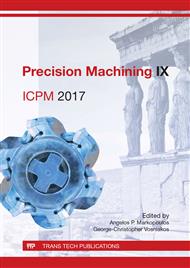[1]
I. Dudás, G. Varga, 3D topography for environmentally friendly machined surfaces, J Phys Conf Ser 13(1) (2005) 24-27.
DOI: 10.1088/1742-6596/13/1/006
Google Scholar
[2]
J. Kundrak, K. Gyani, V. Bana, Roughness of ground and hard-turned surfaces on the basis of 3D parameters, Int J Adv Manuf Technol 38(1-2) (2008) 110-119.
DOI: 10.1007/s00170-007-1086-9
Google Scholar
[3]
J. Kundrák, G. Varga, Possibility of reducing environmental load in hard machining, Key Eng Mat 496 (2012) 205-210.
DOI: 10.4028/www.scientific.net/kem.496.205
Google Scholar
[4]
J. Kundrak, G. Varga, I. Deszpoth, V. Molnar, Some aspects of the hard machining of bore holes, Appl Mech Mater 309 (2013) 126-132.
DOI: 10.4028/www.scientific.net/amm.309.126
Google Scholar
[5]
P. Tamás, B. Illés, P. Dobos, Waste reduction possibilities for manufacturing systems in the industry 4. 0, IOP Conf Ser Mat Sc Eng Volume 161(1) (2016) 012074.
DOI: 10.1088/1757-899x/161/1/012074
Google Scholar
[6]
A.G. Mamalis, J. Kundrak, D.E. Manolakos, K. Gyani, A. Markopoulos, M. Horvath, Effect of the workpiece material on the heat affected zones during grinding: a numerical simulation, Int. J. Adv. Manuf. Tech. 22 (2003) 761-767.
DOI: 10.1007/s00170-003-1685-z
Google Scholar
[7]
E. Brinksmeier, J.C. Aurich, E. Govekar, C. Heinzel, H. -W. Hoffmeister, F. Klocke, J. Peters, R. Rentsch, D.J. Stephenson, E. Uhlmann, K. Weinert, M. Wittmann, Advances in modeling and simulation of grinding processes, CIRP Ann. 55(2) (2006).
DOI: 10.1016/j.cirp.2006.10.003
Google Scholar
[8]
L. Kandráč, I. Maňková, M. Vrabeľ, J. Beňo, Finite element simulation of cutting forces in orthogonal machining of titanium alloy Ti-6Al-4V, Appl. Mech. Mater. 474 (2014) 192–199.
DOI: 10.4028/www.scientific.net/amm.474.192
Google Scholar
[9]
P. Niesłony, W. Grzesik, R. Chudy, W. Habrat, Meshing strategies in FEM simulation of the machining process, Arch. Civ. Mech. Eng. 15(1) (2015) 62–70.
DOI: 10.1016/j.acme.2014.03.009
Google Scholar
[10]
C. Mao, Z.X. Zhou, Y.H. Ren, B. Zhang, Analysis and FEM simulation of temperature field in wet surface grinding, Mater. Manuf. Process. 25(6) (2010) 399–406.
DOI: 10.1080/10426910903124811
Google Scholar
[11]
P. Nieslony, W. Grzesik, M. Bartoszuk, W. Habrat, Analysis of mechanical characteristics of face milling process of ti6al4v alloy using experimental and simulation data, J Mach Eng 16(3) (2016) 58-66.
Google Scholar
[12]
M. Hadad, A. Sharbati, Thermal Aspects of Environmentally Friendly-MQL Grinding Process, Procedia CIRP 40 (2016) 509-515.
DOI: 10.1016/j.procir.2016.01.125
Google Scholar
[13]
A.K. Sharma, A.K. Tiwari, A.R. Dixit, Effects of Minimum Quantity Lubrication (MQL) in machining processes using conventional and nanofluid based cutting fluids: A comprehensive review, J. Clean. Prod. 127 (2016) 1-18.
DOI: 10.1016/j.jclepro.2016.03.146
Google Scholar
[14]
A.A. Minea, Hybrid nanofluids based on Al2O3, TiO2 and SiO2: Numerical evaluation of different approaches, Int. J. Heat Mass Tran. 104 (2017) 852-860.
DOI: 10.1016/j.ijheatmasstransfer.2016.09.012
Google Scholar


